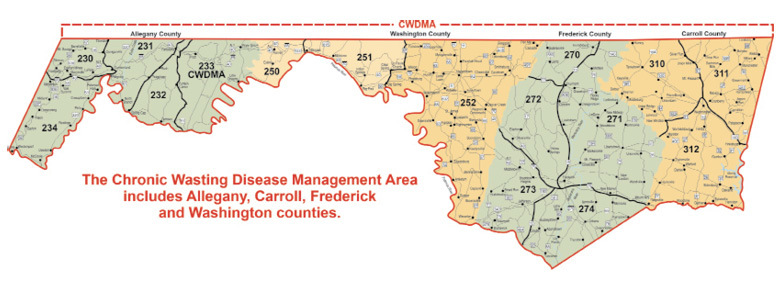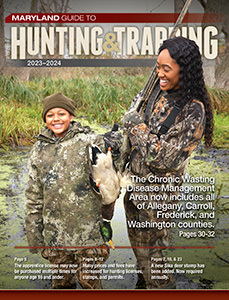Chronic Wasting Disease

Number of Maryland White-tailed Deer that have Tested Positive for Chronic Wasting Disease. Listed by Private Land Codes through the years 2010 – 2022. (See Public & Private Land Codes for Private Land Codes map.) |
||
County |
Land Code |
Number Tested Positive |
Allegany |
230 |
0 |
231 |
31 |
|
232 |
9 |
|
233 |
78 |
|
234 |
0 |
|
Washington |
250 |
25 |
251 |
17 |
|
252 |
7 |
|
Frederick |
270 |
0 |
271 |
1 |
|
272 |
0 |
|
273 |
1 |
|
274 |
1 |
|
Carroll |
310 |
0 |
311 |
0 |
|
312 |
1 |
|
Total |
171 |
|
White-tailed deer harvested on public lands are included in the appropriate private land code. |
||
Chronic Wasting Disease in Maryland
Chronic wasting disease is a disease of the brain and nervous system in the deer family (Cervidae). It has been found in the following free-ranging cervids: elk, moose, mule deer, reindeer and white-tailed deer.
This malady is classified as a transmissible spongiform encephalopathy and attacks the brain of cervids, producing small lesions that eventually result in death. The Department of Natural Resources has tested over 13,300 deer for chronic wasting disease since 2002, and it was first detected in November 2010. The infected deer was harvested by a hunter in Allegany County and was most likely part of an outbreak discovered nearby in Hampshire County, West Virginia, in 2005. To date, 171 infected deer have been detected in Allegany, Carroll, Frederick and Washington counties. Due to the recent detection of CWD in Carroll and Frederick counties, in the 2022-2023 hunting season, the CWDMA has been expanded to include all of Carroll and Frederick counties.
Concerns over chronic wasting disease should not stop hunters from enjoying the hunting season or any venison they may acquire. To date, this encephalopathy has not been shown to be transmissible to humans. However, it is recommended that hunters field dressing or butchering deer take the same precautions as they might to protect against other pathogens or diseases and not consume venison from animals known to be infected. The following common sense precautionary measures are recommended for the safe handling, field dressing and processing of venison:
- Avoid shooting or handling a deer that appears sick.
- Wear latex or rubber gloves when field dressing or butchering deer.
- Remove all internal organs.
- Remove the meat from the bones and spinal column if home processing a deer.
- Do not use household knives or utensils when field dressing or home processing a deer.
- Avoid cutting through bones or the spinal column (backbone).
- If you saw off antlers or through a bone or if you sever the spinal column with a knife, be sure to disinfect these tools prior to using them for the butchering or removal of meat.
- Remove all fat, membranes and connective tissue from the meat. Note that normal field dressing and trimming of fat from meat will remove lymph nodes.
- Always wash hands and instruments thoroughly after dressing and processing game meat.
- Use a 50/50 solution of household chlorine bleach and water to disinfect tools and work surfaces. Wipe down counters and let them dry; soak knives for one hour.
Certain taxidermists and meat processors are currently approved to prepare or process deer carcasses or deer parts taken from within the Chronic Wasting Disease Management Area. This provision provides an opportunity for hunters harvesting deer within the disease management area to transport carcasses or other deer parts directly to one of these approved businesses for meat processing, taxidermy services or for preparation for transport to another taxidermist. Approved CWD processors are indicated in the Deer Processors section. For an up-to-date list of approved processors and taxidermists, please consult the Department of Natural Resource’s website at
Management of Chronic Wasting Disease
Due to the detection of this disease in Allegany, Carroll, Frederick and Washington counties, the Department of Natural Resources has implemented a number of measures to prevent the unintentional spread of this contagion to other locations in Maryland or surrounding states. The changes outlined below apply only to the Chronic Wasting Disease Management Area (Allegany, Carroll, Frederick and Washington counties) on private and public land.
Whole deer carcasses or deer parts cannot be transported out of the disease management area except for:
- Meat with no part of the spinal column, backbone or head attached;
- Hindquarters and front shoulders with no spinal column or backbone attached;
- Cleaned hide with no head attached;
- Skull plate cleaned of all meat and brain tissue;
- Antlers with no meat or soft tissue attached;
- Finished taxidermy mounts or tanned hides;
- Whole deer carcasses or parts being transported directly to approved meat processors or taxidermists.
Please check the Maryland Department of Natural Resources website
Carcass Importation Ban
The primary objective in the management of chronic wasting disease is to prevent its spread into new areas. One possible mode of disease transmission is by the movement and disposal of infected carcasses. In an effort to minimize the risk for disease spread, Maryland along with many other states, has adopted regulations that restrict the importation of whole carcasses and certain carcass parts of deer, moose and elk harvested from states or areas in states that have chronic wasting disease.
A person may not import the whole carcass of a dead deer, elk or moose into Maryland from another state or province’s designated chronic wasting disease containment, surveillance or management area, unless the final destination of the carcass is within the Maryland Chronic Wasting Disease Management Area or with a chronic wasting disease-approved Maryland processor or taxidermist. Travelers may pass through any part of Maryland with whole carcasses from other state/province chronic wasting disease management areas if the carcasses will not remain in the state for more than 24 hours, and no parts are disposed of or remain in the state. A person may import only the following parts of a carcass into Maryland if the final destination is within the state but outside the Chronic Wasting Disease Management Area:
- Meat with no part of the spinal column or head attached;
- Hindquarters and front shoulders with no spinal column or backbone attached;
- Meat without backbone;
- Cleaned hide with no head attached;
- Skull plate cleaned of all meat and brain tissue;
- Antlers with no meat or soft tissue attached;
- Upper canine teeth also known as buglers, whistlers or ivories; and
- Finished taxidermy mount or tanned hides.
Please consult the Chronic Wasting Disease Management Alliance website at
Any person who imports or possesses a cervid carcass or part of a cervid that was tested for chronic wasting disease in another state or province and is notified that the cervid tested positive, must report the test results to the Maryland Department of Natural Resources within 24 hours of receiving such notification by telephone at 301-334-4255; or by email to
If you hunt deer, elk, moose or other cervids in other states and/or provinces, particularly those in which chronic wasting disease has been detected, check with the respective fish and wildlife agencies regarding special regulations or specific advice for hunters. Also check with your home state fish and wildlife agency to ensure that animals lawfully killed elsewhere may be imported and possessed in your state. Additional information can be found at the alliance’s website
Taking Deer Carcasses Out of Maryland
Because Maryland is considered a chronic wasting disease positive state, deer hunters must follow carcass importation regulations in other states when they transport a deer carcass out of Maryland. The surrounding states of Delaware, Pennsylvania, Virginia and West Virginia each have specific regulations as to whether they will allow whole deer carcasses or only parts of carcasses to enter from Maryland. Likewise, the regulations for each of these states vary as to whether they apply to deer from anywhere in Maryland, or just to deer taken within the chronic wasting disease management area. Hunters are strongly encouraged to check state regulations before transporting deer carcasses.

